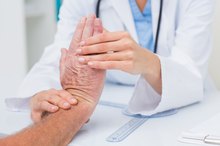It might seem like a simple task to list the most common diseases -- but it's not, for a variety of reasons. First and foremost, there is no national or global tracking system for enumerating the occurrence of most diseases.
If you are experiencing serious medical symptoms, seek emergency treatment immediately.
Other major snags include lack of uniformity in disease definitions, variability from one area to another and difficulty counting conditions that often don't require professional medical care. Nonetheless, certain diseases clearly occur commonly among Americans. Some of these diseases are relatively minor and short-lived, while others persist and are potentially disabling or life-threatening.
Respiratory System
The respiratory system is vulnerable to a variety of diseases.
Upper respiratory infections -- including head colds, throat infections and influenza -- are generally considered the most common diseases worldwide.
Despite the availability of protective vaccines, pneumonia also remains a prevalent disease among Americans and a leading cause of both hospitalizations and death, as reported in July 2015 in "The New England Journal of Medicine."
With regard to long-term respiratory diseases, hay fever, asthma and chronic obstructive pulmonary disease (COPD) predominate. The Centers for Disease Control and Prevention (CDC) reports that about 25.2 million Americans have hay fever, 24.0 million have asthma and 12.1 million are living with COPD 235.
- The respiratory system is vulnerable to a variety of diseases.
- Upper respiratory infections -- including head colds, throat infections and influenza -- are generally considered the most common diseases worldwide.
Cardiovascular System
Causes of Fatigue and Low Fever
Learn More
According to a 2017 report from the American Heart Association (AHA), cardiovascular diseases affect approximately 92.1 million Americans and are the leading cause of death 4. High blood pressure is the most common cardiovascular disease, affecting more than 34 percent of U.S. adults. The AHA report also notes that 16.5 million U.S. adults have coronary heart disease -- the leading cause of heart-related deaths -- and 7.2 million have suffered a stroke.
Musculoskeletal System
CDC estimates that roughly 23 percent of the U.S. population has some form of arthritis, a general term referring to any of several diseases that cause joint pain, inflammation and possibly destruction. Osteoarthritis, also known as degenerative arthritis, is the most common arthritic disease. Other prevalent types include rheumatoid arthritis and gout.
Like arthritis, osteoporosis is another common musculoskeletal disease that predominantly affects older adults. Approximately 10 percent of U.S. adults older than 50 have osteoporosis, and another 44 percent have low bone mass, as reported in the November 2014 issue of the "Journal of Bone and Mineral Research." Low bone mass, formerly known as osteopenia, often progresses to osteoporosis.
- CDC estimates that roughly 23 percent of the U.S. population has some form of arthritis, a general term referring to any of several diseases that cause joint pain, inflammation and possibly destruction.
Skin Diseases
Acute Care Vs. Chronic Care Vs. Long-Term Care
Learn More
It might surprise you that skin diseases rank among the most common ailments. Approximately 50 million Americans have acne, according to the American Academy of Dermatology 6. Noncancerous, precancerous and cancerous skin growths also affect more than 58 million Americans each year, according to a September 2014 report in "The Journal of Clinical and Aesthetic Dermatology."
Other commonplace skin diseases include: -- Allergic and irritant contact dermatitis.
-- Warts, cold sores and genital herpes.
-- Jock itch, athlete's foot, ringworm and yeast infections.
-- Boils and cellulitis. -- Psoriasis, atopic dermatitis, seborrheic dermatitis and rosacea.
- It might surprise you that skin diseases rank among the most common ailments.
- Noncancerous, precancerous and cancerous skin growths also affect more than 58 million Americans each year, according to a September 2014 report in "The Journal of Clinical and Aesthetic Dermatology."
Mental Illnesses and Developmental Disorders
Mental illnesses occur far more frequently than many people realize. The National Institute of Mental Health (NIMH) estimates that 43.4 million U.S. adults, or nearly 18 percent of those aged 18 or older, had a mental illness in 2015 -- and this figure does not include people with a substance use disorder. Anxiety disorders occur most frequently, followed by personality and mood disorders, including major depression and bipolar disorder. Attention-deficit hyperactivity disorder (ADHD) is the most common developmental disorder, affecting roughly 9 percent of children and 4 percent of adults, reports NIMH.
- Mental illnesses occur far more frequently than many people realize.
- Attention-deficit hyperactivity disorder (ADHD) is the most common developmental disorder, affecting roughly 9 percent of children and 4 percent of adults, reports NIMH.
Digestive System
CDC reports that 1 in 6 Americans gets sick with a foodborne illness each year. These diseases, known generally as gastroenteritis, are typically due to contamination of food with viruses, bacteria or parasites and usually clear within a few days to weeks. More persistent, common diseases of the digestive system include: -- Gastroesophageal reflux disease (GERD). -- Gallstones.
-- Diverticulosis, or outpouching of the intestines. -- Ulcers of the stomach or first part of the small intestine.
- CDC reports that 1 in 6 Americans gets sick with a foodborne illness each year.
- More persistent, common diseases of the digestive system include: -- Gastroesophageal reflux disease (GERD).
- --
Neurological System
Headache disorders are the most common of the neurological diseases, with migraines leading the pack.
A January 2015 article in the journal "Headache" reports that approximately 14 percent of Americans experience migraines in a given year.
Chronic tension-type headaches, which occur at least 15 days per month, affect roughly 4 percent of U.S. adults, according to a July 2009 "Clinical Evidence" article 10. Although rare in younger adults, Alzheimer disease affects 1 out of 9 seniors aged 65 or older, according to a 2016 report from the Alzheimer's Association.
- Headache disorders are the most common of the neurological diseases, with migraines leading the pack.
- Chronic tension-type headaches, which occur at least 15 days per month, affect roughly 4 percent of U.S. adults, according to a July 2009 "Clinical Evidence" article 10.
Urinary and Reproductive Systems
Urinary and reproductive system infections affect millions of Americans annually. Urinary tract infections (UTIs) affect 11 percent of women each year, according to an October 2013 "Current Urology Reports" review article. Children and men experience UTIs, but less frequently. **Sexually transmitted diseases are also common.
** CDC estimates that 4.5 million new chlamydia, gonorrhea and genital herpes infections occur yearly in the United States.
**Vaginal yeast infections and bacterial vaginosis occur even more frequently.
With respect to common long-term conditions, approximately 14 percent of Americans have chronic kidney disease, reports the National Institute of Diabetes and Digestive and Kidney Diseases. Most cases are caused by longstanding diabetes or high blood pressure. **
- Urinary and reproductive system infections affect millions of Americans annually.
- CDC estimates that 4.5 million new chlamydia, gonorrhea and genital herpes infections occur yearly in the United States.
Endocrine Diseases
**Diabetes mellitus and prediabetes are the most common endocrine, or hormonal, diseases in the United States A 2014 CDC report indicates that 29.1 million Americans -- approximately 9 percent of the population -- have diabetes, and another 86.0 million have prediabetes.
** Roughly 95 percent of people with diabetes have type 2 diabetes. Thyroid disease also occurs frequently among Americans. Guidelines from the American Association of Clinical Endocrinologists and the American College of Endocrinology indicate that approximately 5 to 9 percent of the U.S. population have hypothyroidism, an underactive thyroid gland 6. Another 1 percent have hyperthyroidism, with excess thyroid hormone.
- Diabetes mellitus and prediabetes are the most common endocrine, or hormonal, diseases in the United States A 2014 CDC report indicates that 29.1 million Americans -- approximately 9 percent of the population -- have diabetes, and another 86.0 million have prediabetes.
- Another 1 percent have hyperthyroidism, with excess thyroid hormone.
Many Other Important Diseases
**The most common diseases often command the greatest attention and healthcare resources.
However, many very important and serious diseases don't necessarily qualify for the moniker "most common" -- such as HIV/AIDS, cancer and chronic viral hepatitis. ** In other words, commonality and importance or seriousness do not necessarily go hand in hand. Indeed, for anyone who is ill, the most important disease is the one that individual is trying to overcome or learning to manage.
Reviewed by: Mary D. Daley, M.D.
- The most common diseases often command the greatest attention and healthcare resources.
- However, many very important and serious diseases don't necessarily qualify for the moniker "most common" -- such as HIV/AIDS, cancer and chronic viral hepatitis.
Related Articles
References
- The New England Journal of Medicine: Community-Acquired Pneumonia Requiring Hospitalization Among U.S. Adults
- Centers for Disease Control and Prevention: Asthma
- Centers for Disease Control and Prevention: Estimates of Foodborne Illness in the United States
- Circulation: Heart Disease and Stroke Statistics -- 2017 Update: A Report From the American Heart Association
- Centers for Disease Control and Prevention: Chronic Obstructive Pulmonary Disease (COPD) Includes: Chronic Bronchitis and Emphysema
- American Academy of Dermatology Association: Acne Clinical Guideline
- Cutis: Most Common Dermatologic Conditions Encountered by Dermatologists and Nondermatologists
- The Journal of Clinical and Aesthetic Dermatology: Comprehensive Management of Actinic Keratoses, Practical Integration of Available Therapies With a Review of a Newer Treatment Approach
- Headache: The Prevalence and Burden of Migraine and Severe Headache in the United States: Updated Statistics From Government Health Surveillance Studies
- Clinical Evidence: Headache (Chronic Tension-Type)
Resources
- Alzheimer's Association: 2016 Alzheimer's Disease Facts and Figures
- National Institute of Mental Health: Any Mental Illness (AMI) Among U.S. Adults
- National Institute of Mental Health: What Is Prevalence?
- Current Urology Reports: From Physiology to Pharmacy: Developments in the Pathogenesis and Treatment of Recurrent Urinary Tract Infections
- Centers for Disease Control and Prevention: Chlamydia - CDC Fact Sheet (Detailed)
- Centers for Disease Control and Prevention: Genital Herpes - CDC Fact Sheet (Detailed)
- Centers for Disease Control and Prevention: Gonorrhea - CDC Fact Sheet (Detailed Version)
- Centers for Disease Control and Prevention: National Diabetes Statistics Report, 2014
Writer Bio
Norene Anderson has been a writer since 2003. She is also a registered nurse with expertise in a wide range of medical conditions and treatments. Anderson received her associate degree in nursing from Lincoln University in Jefferson City, Mo.








